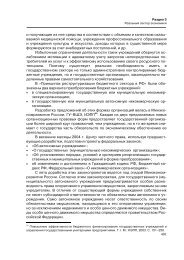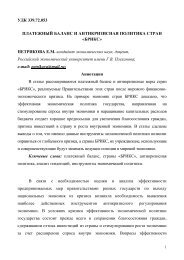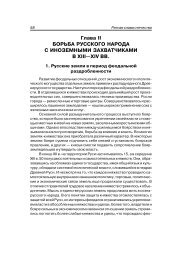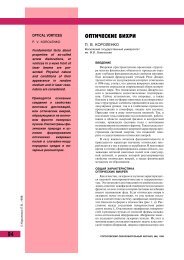idea known to Brezhnev, but it was also discarded after <strong>the</strong> discussion <strong>and</strong> fierce contestation at <strong>the</strong> highest level. Academician Yevgeny Velikhovrightly remarked that those discussions had fostered a sort of immunity to such “star wars” ideas <strong>in</strong> <strong>the</strong> Soviet scientific community.70. Strobe Talbott, “The Master of <strong>the</strong> Game: Paul Nitze <strong>and</strong> <strong>the</strong> Nuclear Peace,” New York: Knopf, 1988, p. 217.71. See M. A. Gareyev, “<strong>Strategic</strong>heskoye sderzhivanie: problemy i resheniya” (“<strong>Strategic</strong> Deterrence: Problems <strong>and</strong> Solutions”), Krasnaya Zvezda, 8October 2008.72. See, first of all, A. A. Svech<strong>in</strong>, “Strategiya” (“Strategy”), Moscow: Voyenny Vestnik, 1926.73. This is atta<strong>in</strong>ed through some losses for <strong>the</strong> “throw-weight” (<strong>the</strong> weight that a missile delivers to <strong>the</strong> ballistic trajectory), but <strong>the</strong>se losses turnout to be justified.74. See “Kosmicheskoye oruzhie: dilemma bezopasnosti” (“Space Weapons: Security Dilemma”), exec. eds. E. P. Velikhov, A. A. Kokosh<strong>in</strong>, <strong>and</strong> R.Z. Sagdeyev Moscow: Mir, 1986; S. K. Oznobischev, V. Ya. Potapov, V. V. Skokov, “Kak gotovilsya ‘asimmetrichny otvet’ na ‘<strong>Strategic</strong>heskuyu oboronnuyu<strong>in</strong>itsiativu’ R. Reigana” (“How <strong>the</strong> ‘Asymmetric Response’ to R. Reagan’s ‘<strong>Strategic</strong> Defense Initiative Was Prepared”), Velikhov, Kokosh<strong>in</strong>et al., Moscow: Len<strong>and</strong> / URSS, 2008; A. Fenenko, “Asimmetrichny otvet v novom veke” (“Asymmetric Response <strong>in</strong> <strong>the</strong> New Century”), Mezhdunarodnyeprotsessy 6, no. 3/18, September-December 2008, pp. 121–125.75. “Udarnye kosmicheskiye vooruzheniya i mezhdunarodnaya bezopasnost: Doklad Komiteta sovetskikh uchenykh v zaschitu mira, protiv yadernoiugrozy” (“Space Strike Weapons <strong>and</strong> International Security: Report of <strong>the</strong> Soviet Scientists’ Committee for Peace Aga<strong>in</strong>st <strong>the</strong> Nuclear Threat”),concise abridged version, Moscow: APN, 1985, p. 41.76. In all, accord<strong>in</strong>g to <strong>the</strong> estimates of Soviet scientist Alex<strong>and</strong>er Vasiliev, <strong>in</strong> <strong>the</strong> event of complete implementation of <strong>the</strong> plans on development<strong>and</strong> build-up of <strong>the</strong> U.S. strategic nuclear forces, which were projected <strong>in</strong> <strong>the</strong> first half of <strong>the</strong> 1980s, <strong>the</strong> U.S. “counterforce” potential could <strong>in</strong>creaseabout six times by <strong>the</strong> second half of <strong>the</strong> 1990s compared to 1983. See A. A. Vasiliev, “Nekotorye tendentsii razvitiya strategicheskikh yadernykhsil Soed<strong>in</strong><strong>in</strong>nykh Shtatov Ameriki i ikh protivosilovykh kharakteristik do vtoroi polov<strong>in</strong>y 1990-kh godov” (“Certa<strong>in</strong> Trends of Development of <strong>the</strong>U.S. <strong>Strategic</strong> Nuclear Forces <strong>and</strong> its Counterforce Characteristics through <strong>the</strong> Second Half of <strong>the</strong> 1990s”). See also “Problema zamorazhivaniyayadernogo oruzhiya: Doklad Komiteta sovetskikh uchenykh v zaschitu mira, protiv yadernoi ugrozy” (“Nuclear Weapons Freeze Problems: Reportof <strong>the</strong> Soviet Scientists’ Committee for Peace aga<strong>in</strong>st <strong>the</strong> Nuclear Threat”), Moscow, 1984, p. 27.77. Central Europe, by virtue of its strategically crucial location, for quite a while has had a special position with<strong>in</strong> <strong>the</strong> system of military <strong>and</strong>political relations on <strong>the</strong> European cont<strong>in</strong>ent. This region has <strong>the</strong> most extensive <strong>and</strong> substantial traffic network, a very high density of <strong>the</strong> population<strong>and</strong> a very high degree of <strong>in</strong>dustrial cluster<strong>in</strong>g. Therefore, if a military conflict broke out <strong>in</strong> Central Europe, it could have easily spread to anyo<strong>the</strong>r region on <strong>the</strong> cont<strong>in</strong>ent, especially if we take account of <strong>the</strong> operat<strong>in</strong>g range <strong>and</strong> destructive potential of <strong>the</strong> tactical <strong>and</strong> operational-tacticalnuclear weapons deployed <strong>in</strong> <strong>the</strong> region. It was exactly this <strong>the</strong>ater of military operations where <strong>the</strong> oppos<strong>in</strong>g forces were primarily meant tobecome non-offensive.78. In this respect we welcome <strong>the</strong> use of <strong>the</strong> term “non-offensive defense” for def<strong>in</strong><strong>in</strong>g <strong>the</strong> basic pr<strong>in</strong>ciples of development of regimes for armscontrol, confidence-build<strong>in</strong>g, military restra<strong>in</strong>t <strong>and</strong> reasonable adequacy <strong>in</strong> military development <strong>in</strong> <strong>the</strong> Russian “advanced version of <strong>the</strong> elementsof <strong>the</strong> European Security Treaty,” which was presented by Russian M<strong>in</strong>ister of Foreign Affairs Sergei Lavrov <strong>in</strong> his address to <strong>the</strong> OSCE M<strong>in</strong>isterialCouncil at a breakfast meet<strong>in</strong>g on 5 December 2008. http://www.mid.ru/brp 4.nsf/2fee282eb6df40e643256999005e6e8c/ 4d65fb04bac5fb77c325751600475915?OpenDocument79. If we talk about an <strong>in</strong>crease <strong>in</strong> combat capabilities of <strong>the</strong> Russian Federation, <strong>the</strong>n we should first of all discuss <strong>the</strong> entire complex of <strong>in</strong>formation-analysisfacilities united <strong>in</strong>to a powerful flexible super-system (or <strong>the</strong> “system of systems”) that covers all control l<strong>in</strong>ks. The management(control) component of <strong>the</strong> revolution <strong>in</strong> military affairs is often overlooked by both <strong>the</strong> analysts <strong>and</strong> practical managers. However, it is becom<strong>in</strong>gespecially important by virtue of <strong>the</strong> nature of present-day combat, operations <strong>and</strong> ongo<strong>in</strong>g paradigm shifts <strong>in</strong> <strong>the</strong> forms <strong>and</strong> <strong>the</strong> methods ofwarfare, which tend to become more <strong>and</strong> more complex. We are witness<strong>in</strong>g a considerable <strong>in</strong>crease <strong>in</strong> <strong>the</strong> number of components of global armedforces <strong>and</strong> <strong>in</strong> <strong>the</strong> sophistication of battle arrays; this requires more <strong>in</strong>-depth ref<strong>in</strong>ement of <strong>in</strong>teraction between <strong>the</strong> aforementioned components—vertically,horizontally, <strong>in</strong> various matrix comb<strong>in</strong>ations, <strong>and</strong> <strong>in</strong>tegrally. This system must have highly <strong>in</strong>tegrated means of reconnaissance,surveillance, communications, telecommunications, navigation, relay<strong>in</strong>g, target designation, topographical survey<strong>in</strong>g, detection of launchesof new-generation ballistic missiles, target-recognition, control, missile-strike systems, aviation, <strong>and</strong> electronic warfare provid<strong>in</strong>g for absolutesuperiority on <strong>the</strong> battlefield at least for a relatively short period of time. (In particular, <strong>the</strong>re is a long overdue need to make an <strong>in</strong>ventory of <strong>the</strong>technical reconnaissance assets of <strong>the</strong> Ma<strong>in</strong> Intelligence Directorate, <strong>the</strong> Navy, <strong>the</strong> Air Forces <strong>and</strong> <strong>the</strong> Ground Forces <strong>in</strong> order to provide for <strong>the</strong>irsubsequent <strong>in</strong>tegration <strong>and</strong> unification, as well as <strong>the</strong> possibility of <strong>the</strong>ir conjugation with electronic warfare.) The availability of uniform st<strong>and</strong>ardizedtools <strong>and</strong> protocols for data process<strong>in</strong>g <strong>and</strong> presentation plays an important role <strong>in</strong> this system. International <strong>and</strong> Russian experience showsthat this task is extremely topical, <strong>in</strong> particular, for <strong>in</strong>telligence services <strong>in</strong> general <strong>and</strong> for certa<strong>in</strong> components of <strong>in</strong>telligence services <strong>in</strong> particular.Meanwhile, present-day war is <strong>in</strong> many respects a war between compet<strong>in</strong>g <strong>in</strong>telligence services.80. For more details, see Kokosh<strong>in</strong>, “Innovatsionnye vooruzhennye sily i revolyutsiya v voyennom dele” (“Innovative Armed Forces <strong>and</strong> <strong>the</strong> Revolution<strong>in</strong> Military Arts”), Moscow: Len<strong>and</strong> / URSS, 2009.81. Electronic warfare is a means of reduction of <strong>the</strong> opponent’s real combat efficiency, a means of mis<strong>in</strong>formation <strong>and</strong> deception of <strong>the</strong> opponent,<strong>and</strong> a means of defragmentation of <strong>the</strong> opponent’s control system. Electronic countermeasures should ultimately result <strong>in</strong> suppression of <strong>the</strong>adversary’s will to resist; <strong>the</strong> will must be suppressed exactly when it is necessary to take <strong>and</strong> reta<strong>in</strong> <strong>the</strong> <strong>in</strong>itiative (strategic, operational, <strong>and</strong> tactical).It is such suppression of <strong>the</strong> will to resist, which is <strong>the</strong> pr<strong>in</strong>cipal task of any warfare, notwithst<strong>and</strong><strong>in</strong>g <strong>the</strong> still prevail<strong>in</strong>g op<strong>in</strong>ion that <strong>the</strong> mostimportant factor is physical annihilation of <strong>the</strong> adversary’s troops <strong>and</strong> military hardware.66<strong>Ensur<strong>in</strong>g</strong> <strong>Strategic</strong> <strong>Stability</strong> <strong>in</strong> <strong>the</strong> <strong>Past</strong> <strong>and</strong> <strong>Present</strong>: Theoretical <strong>and</strong> Applied Questions
82. In this area, like <strong>in</strong> many o<strong>the</strong>r areas, as a result of assignment of unrealistic, overstated tasks, operational <strong>and</strong> combat tra<strong>in</strong><strong>in</strong>g for <strong>the</strong> comm<strong>and</strong>staff becomes “decorative.”83. The problem of non-proliferation of biological <strong>and</strong> bacteriological weapons is equally (or even more) important from <strong>the</strong> po<strong>in</strong>t of view of actuallysecur<strong>in</strong>g strategic stability, especially <strong>in</strong> <strong>the</strong> context of <strong>the</strong> latest achievements <strong>in</strong> gene eng<strong>in</strong>eer<strong>in</strong>g <strong>and</strong> <strong>the</strong> extensive work that is carried out <strong>in</strong>that field by state, academic, <strong>and</strong> corporate research <strong>and</strong> development centers. The Convention on <strong>the</strong> Prohibition of <strong>the</strong> Development, Production<strong>and</strong> Stockpil<strong>in</strong>g of Bacteriological (Biological) <strong>and</strong> Tox<strong>in</strong> Weapons <strong>and</strong> on <strong>the</strong>ir Destruction as of 1972 def<strong>in</strong>itely needs amendment <strong>and</strong> elaboration.However, from what I can see, this issue is beyond <strong>the</strong> scope of strategic stability <strong>in</strong> its current underst<strong>and</strong><strong>in</strong>g.84. In <strong>the</strong> beg<strong>in</strong>n<strong>in</strong>g of <strong>the</strong> 1990s, Trutnev wrote that <strong>the</strong> atta<strong>in</strong>ed level of development of nuclear-power eng<strong>in</strong>eer<strong>in</strong>g <strong>in</strong> <strong>the</strong> Third World countries(<strong>the</strong> total volume amounted to 50 percent of <strong>the</strong> volume of nuclear-power eng<strong>in</strong>eer<strong>in</strong>g <strong>in</strong> <strong>the</strong> USSR) stipulated <strong>the</strong> annual use of a substantialamount of uranium fuel that amounted to 400 to 500 tons of uranium dioxide (where <strong>the</strong> uranium-235 enrichment level was 3 percent). Accord<strong>in</strong>gto Trutnev’s estimate, “this amount is sufficient (if <strong>the</strong> relevant decision is made) for mak<strong>in</strong>g 15 tons of weapon-grade uranium highly enrichedwith isotope U235 <strong>and</strong> production of several hundreds of warheads with relatively high parameters.” Ano<strong>the</strong>r opportunity to use nuclear-powereng<strong>in</strong>eer<strong>in</strong>g for establish<strong>in</strong>g nuclear arsenals <strong>in</strong> <strong>the</strong> Third World countries is <strong>the</strong> use of transuranium elements conta<strong>in</strong>ed <strong>in</strong> <strong>the</strong> spent fuel. Accord<strong>in</strong>gto Trutnev’s estimates, <strong>the</strong> annual amount of plutonium isotopes at <strong>the</strong> aforementioned reactors at that time amounted to between 3 <strong>and</strong> 4 tons,which was also sufficient for mak<strong>in</strong>g many hundreds of nuclear warheads. See Trutnev, p. 337.85. Several estimates show that by <strong>the</strong> first quarter of 2009, Iran enough low-enriched uranium to manufacture at least one nuclear warhead if <strong>the</strong>uranium were reprocessed <strong>in</strong>to highly-enriched uranium.86. It is believed that Israel’s nuclear-warhead delivery vehicles may <strong>in</strong>clude fighter-bomber aircraft with a combat radius of 1,600 km, groundlaunchedJericho ballistic missiles with a range of 1,500 to 1,800 km, <strong>and</strong> sea-based cruise missiles launched from non-nuclear vessels like <strong>the</strong> German-madeDolph<strong>in</strong> submar<strong>in</strong>es that Israel buys abroad. There is speculation that Israel has produced such nuclear munitions as artillery shells <strong>and</strong>m<strong>in</strong>es. See “Armaments, Disarmament <strong>and</strong> International Security,” SIPRI Yearbook 2007, pp. 590–591. The estimated number of Israel’s nuclearmunitions is 100 to 200 plutonium warheads. Israel predom<strong>in</strong>antly adheres to <strong>the</strong> policy of “nuclear uncerta<strong>in</strong>ty,” officially nei<strong>the</strong>r confirm<strong>in</strong>g norrefut<strong>in</strong>g <strong>the</strong> fact that it has nuclear weapons.87. See Graham Allison, “Nuclear Terrorism: The Ultimate Preventable Catastrophe,” New York: Owl Books / Henry Holt, 2005, pp. 76–77.88. The cont<strong>in</strong>u<strong>in</strong>g erosion of <strong>the</strong> situation <strong>in</strong> Afghanistan <strong>and</strong> Nor<strong>the</strong>rn Pakistan to <strong>the</strong> advantage of Islamic terrorists constitutes a threat that ata certa<strong>in</strong> moment, Pakistan’s nuclear weapons may to one extent or ano<strong>the</strong>r (directly or <strong>in</strong>directly) end up <strong>in</strong> <strong>the</strong> h<strong>and</strong>s of Islamic extremists, withall <strong>the</strong> ensu<strong>in</strong>g consequences. Unchecked fur<strong>the</strong>r development of <strong>the</strong> situation <strong>in</strong> <strong>the</strong> aforementioned zone will force Russia <strong>and</strong> its allies, under<strong>the</strong> Collective Security Treaty Organization <strong>and</strong> <strong>the</strong> Shanghai Cooperation Organization, to make certa<strong>in</strong> new decisions. In this respect, a specialrole should be played by Russia’s agreements with Ch<strong>in</strong>a, India <strong>and</strong> Iran, which should constitute <strong>the</strong> basis of Russia’s policy toward Afghanistan,Pakistan <strong>and</strong> <strong>the</strong> activities of <strong>the</strong> United States <strong>and</strong> its NATO allies <strong>in</strong> this region.89. S. A. Oborotov, “Yaderny factor v amerikano-<strong>in</strong>diyskikh otnosheniyakh” (“The Nuclear Factor <strong>in</strong> U.S.-India Relations”), 1991–2008. MoscowLibrocom/URSS, 2009, p. 104.90. Oborotov notes that tactical <strong>and</strong> technical characteristics of <strong>the</strong> Ghauri were superior to those of India’s short-range Prithvi missile, which wasready for deployment, while <strong>the</strong> medium-range Agni missile was still under development <strong>and</strong> needed to be tested. See S. A. Oborotov, op. cit., pp.102–103.91. Oborotov, op. cit., p. 103.92. Ibid., pp. 104–110.93. Ibid., pp. 112–113.94. V. I. Sotnikov, “Yadernaya problema v <strong>in</strong>do-pakistanskikh otnosheniyakh (vtoraya polov<strong>in</strong>a XX – nachalo XXI v.)” (“The Nuclear Problem <strong>in</strong>India-Pakistan Relations [Second Half of <strong>the</strong> 20th Century—Beg<strong>in</strong>n<strong>in</strong>g of <strong>the</strong> 21st Century]”), Moscow: Nauchnaya Kniga, 2003, pp. 160–161.95. “We have made clear that <strong>the</strong> system we <strong>in</strong>tend to pursue with Russia will not be a jo<strong>in</strong>t system, <strong>and</strong> it will not <strong>in</strong> any way limit United States’ orNATO’s missile defense capabilities,” Letter from U.S. President Barack Obama to U.S. Senate Majority Leader Harry M. Reid, 19 December 2010.Available at:http://www.america.gov/st/texttrans-english/2010/December/20101220112111su0.6327565.html#ixzz1HjNgkHn696. A number of U.S. experts <strong>and</strong> representatives of <strong>the</strong> military department express grave dissatisfaction <strong>and</strong> serious concerns about <strong>the</strong> problemsof modernization of <strong>the</strong> U.S. nuclear weapons complex <strong>and</strong> its ability to provide for modernization of <strong>the</strong> U.S. nuclear weapons arsenal.97. The <strong>Strategic</strong> Offensive Reductions Treaty (SORT) between <strong>the</strong> United States <strong>and</strong> <strong>the</strong> Russian Federation as of 24 May 2002 mentions <strong>the</strong>necessity of build<strong>in</strong>g of “a qualitatively new foundation for strategic relations between <strong>the</strong> Parties,” <strong>and</strong> <strong>the</strong> desire “to establish a genu<strong>in</strong>e partnershipbased on <strong>the</strong> pr<strong>in</strong>ciples of mutual security, cooperation, trust, openness, <strong>and</strong> predictability.” We all know very well how Wash<strong>in</strong>gton de-factoimplemented <strong>the</strong>se pr<strong>in</strong>ciples.Belfer Center for Science <strong>and</strong> International Affairs | Harvard Kennedy School 67
















